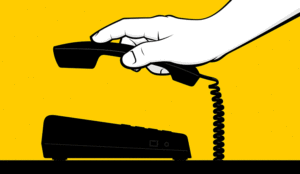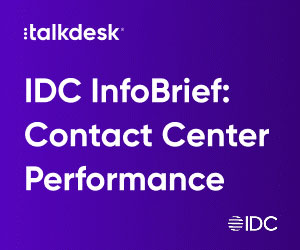What happens when a customer hangs up the phone before talking with a customer service agent?
This may occur for various reasons. However, it is a reliable metric for showing contact is closely linked to customer satisfaction. A lower call abandonment rate is always preferable, whereas a higher rate should concern the business.
What Is Call Abandonment Rate in Call Centres?
The call abandonment rate is a metric that indicates how many customers hang up the phone before their call is answered in the contact centre.
In every business, the call abandonment rate fluctuates throughout the workday based on service performance and queue strategy, such as on-hold messaging, hold music, and IVR options.
We have tried to explain the call abandonment rate in this section. However, it would help if you did not mistake abandonment rate with the following types of calls:
- Missed Calls: These are calls that the call centre has purposely disconnected. This happens when an inbound call reaches the contact centre’s ACD system’s maximum waiting restriction.
- Dropped Calls: These are calls that the call centre unintentionally disconnects due to a technical issue. For landline calls, this happens once every thousand calls.
- Lost Calls: These include all calls that are lost, including missed, dropped, and abandoned calls. While an abandoned call is a lost call, a lost call is not always an abandoned one.
- Short Calls: A short call is one in which the caller hangs up shortly after the advisor answers the phone. These calls are not considered abandoned.
If a business does not manage call queues, callers may take to social media and write negative complaints about them.
They also may abandon the business after a terrible client experience and seek an alternative.
In this situation, other customer satisfaction metrics drop too because customers are not communicating with customer service personnel.
What Is the Industry Standard Call Centre Abandonment Rate?
A high call abandonment rate is usually caused by one of two reasons. First, the customers give up because the waiting time is far too long.
Alternatively, there may be some deficiencies in the waiting experience a business provides for their customers, such as lousy hold music or ambiguous expectations about waiting time.
When customers hang up without receiving the expected help, it causes poor customer service, leading to losing customers.
An abandonment rate of 2 percent is considered good, and a rate of 5 is acceptable. Anything exceeding 5 percent would be considered problematic.
An excellent abandonment rate in one business may not be so great. For example, a 5 percent call abandonment rate would be unacceptable in a competitive retail market, as each abandonment represents a potential lost consumer.
On the other hand, you may tolerate a greater abandonment rate if you work in technical support because the customer will be more ready to wait. After all, you will have the answers they need.
How to Calculate Call Abandonment Rate in 3 Steps
Knowing the call centre abandonment rate industry-standard as described, it is not difficult to figure out the call abandonment rate for a business. Follow the following steps:
1. Count the Number of Phone Calls Received
The first step in this process is to figure out how many calls the business has received in a certain period. For example, most businesses measure every month.
However, if a business knows weekly, yearly, or any other timeframe suits its needs, it is up to the managers to choose the best timeframe.
2. Subtract the Number of Answered Calls From the Total
After determining how many calls a business has received in a particular timeframe, subtract the number of answered calls from the total.
Some businesses may define “handled call” differently than others for this phase. For example, the phone conversation was brief, less than five seconds, so it may be classified as abandoned.
3. Divide the Result by the Number of Received Calls
After deducting the number of handled calls from the total number of received calls in the customer service, divide the difference by the total number of calls.
It should yield a decimal figure, which you can multiply by 100 to obtain a percentage.
For example, suppose a call centre got 500 calls this month, of which the customer service team handled 460.
Therefore, call abandonment rate for this business would be as follows:
500 – 460 = 40
40 / 500 = 0.08
0.08 * 100 = 8
It means the abandonment rate for this imaginary call centre is 8 percent, which is a little high compared to the call centre abandonment rate industry-standard, as mentioned.
How to Improve Abandonment Rate Call Centre Metric?
Call centres must improve their wait and response time, deal with scheduling issues, take post-call notes, and track call duration to reduce the call abandonment rate as much as possible.
In this section, we try to point out ten proven ways to improve the call abandonment rate by comparing call centre abandonment rate industry standards in this business.
1. Calculate Call Abandonment Rate
Start with calculating the call abandonment rate for the intended business. Then comes automation as an essential factor.
For better customer service, automation is the way to go. It may seem like too much work if you are coming from a manual system, but it all be worth it.
It is the only way to get customer data as soon as they contact, giving representatives a better understanding of their accounts.
It saves every call centre by spending less on customer acquisition and having higher retention rates with automated customer service systems.
2. Increase Response Time
It should not take more than 20 to 30 seconds between two steps:
- When the customer decides to chat with a customer service agent by picking up the phone, and
- When there is some agent on the line.
However, some studies have revealed that some businesses take an average of a minute or more. Predictive behavioral routing, among other approaches, may help improve this area.
3. Identify Customers in the Call Queue
When the number of calls to agents is too large, abandon rates become a concern.
When growing personnel is not an option for a business, the focus should be on streamlining the overall customer support process.
Identifying customers as they are waiting in the phone queue can help to lower the call abandonment rate for a call centre.
Simply confirming consumer information while they wait shows them that the company is concerned about their problem.
4. Use Automatic Callbacks
Contact centres should consider integrating a popular feature within an IVR system that allows a caller to choose to be called back rather than wait on hold in the phone queue to lower abandonment rates.
When an advisor becomes available, the system calls the customer and connects them to a customer service agent.
Some IVRs also include an option for the consumer to schedule a callback at a convenient time.
Callbacks improve the customer experience since callers are relieved of the frustration of waiting on hold in a long call queue.
If your demand is not spiky, though, callbacks should be avoided. However, there is little doubt that they can improve customer service, but lineups may lengthen if phone numbers remain high.
5. Organize Scheduling
If a contact centre is not appropriately staffed to meet demand, customers may be forced to wait on hold for longer than necessary. This is mainly due to a failure to forecast demand within a specific timeframe.
6. Notice After the Call
This refers to all of an agent’s extra responsibilities after answering the phone.
Everything customer service agents do after the call may divert their attention away from the phone lines, resulting in scheduling conflicts and resolution delays.
7. Keep Track of Call Duration
Everybody knows that some problems take longer to resolve than others. However, failing to plan for the complicated issues may cause agents to spend more time on the phone.
This process extends the time to fix the issue and diminishes customer satisfaction.
If customer service agents are on the phone for an extended period, this might result in longer wait times for new callers and more abandoned calls.
8. Boost First-Call Resolution
It is also worth noting that the call abandonment rate is more remarkable when a caller does not get the desired result on the first call.
If someone calls for the second, third, or even fourth time about the same problem or inquiry, they are more likely to feel frustrated and hang up the phone. It could be attributable, among other things, to a call centre agent scarcity.
A low abandonment rate does not mean the given business is on top of customer satisfaction, which is likely the most critical metric.
Someone is unlikely to be pleased if they have to call five times about the same problem, even if all five calls were officially “fixed” as soon as possible.
Many clients mistake setting the bar too low in this regard. However, you must be able to think beyond the phrase, “Customers are satisfied as long as they are not complaining.”
9. Analyze Failure Demand
If your abandon rates are high due to higher call demand, figuring out where the extra demand is coming from and resolving the problem should be a top concern.
Organizations may get to the underlying cause of any process or routing difficulties by employing technology like interaction analytics to determine customer call reasons and frequency.
Not only can the contact centre employ failure demand analysis to predict and plan for future call volume spikes, it can also proactively build resources to meet customer needs while enhancing and lowering inefficiencies and abandonment.
10. Use Workforce Management Software
Workforce management software (WFM) solutions help customer service teams repair gaps, reschedule agents, and reduce customers’ waiting time by automatically identifying the right skills.
Team leaders may successfully manage last-minute absence requests without compromising service standards.
Advanced optimizer and intraday adherence tools automatically compare staffing levels to metrics and service levels while lowering abandon rates.
Intraday self-scheduling solutions assist advisers in gaining control over their new Workforce Management Software, increasing productivity and morale.
Final Thoughts
Customer satisfaction suffers due to long waiting times, which may eventually affect customer retention. By lowering the call abandonment rate in a business, it can manage more calls and deliver a better customer service experience.
Fortunately, many call centre technologies available can assist you in tackling high abandonment rates and provide further cooperation and communication benefits in the future.
Read this article carefully to find out the call centre abandonment rate industry standard and some ways to improve the call abandonment rate.
For more information about Scorebuddy - visit the Scorebuddy Website
Call Centre Helper is not responsible for the content of these guest blog posts. The opinions expressed in this article are those of the author, and do not necessarily reflect those of Call Centre Helper.
Author: Scorebuddy
Published On: 31st May 2022 - Last modified: 14th Mar 2025
Read more about - Guest Blogs, Scorebuddy






 Scorebuddy is quality assurance solution for scoring customer service calls, emails and web chat. It is a dedicated, stand-alone staff scoring system based in the cloud, requiring no integration.
Scorebuddy is quality assurance solution for scoring customer service calls, emails and web chat. It is a dedicated, stand-alone staff scoring system based in the cloud, requiring no integration. 









